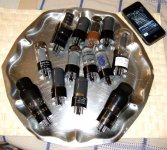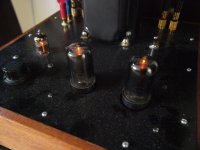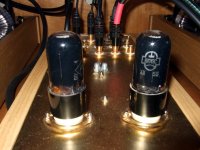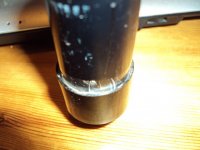I am trying to identify the musical worth of black bodied 6V6GTs. I have received three large boxes of very old valves over the last few weeks and have been sorting and listening to (where possible) the valves I can identify.
Of the most prized (from my point of view) have been some very old 5U4GBs - Australian made and 5Y3s (rec. tubes). But I also have about 9 black bodied 6V6GTs. These are quite squat valves. In fact some are slightly smaller than others. I managed to find two batch matched pairs from two different manufactures. One being Radiotron and the other Mullard both Australian made. Both of these pairs of valves work and I have listened briefly to both pairs on my SE UL valve power amp.
The valves appear to be painted or sprayed black inside to the point where you cannot identify the elements within. It is even hard to tell if they are on.
Can someone shed some light on these interesting valves and pass comment on their audio qualities.
Of the most prized (from my point of view) have been some very old 5U4GBs - Australian made and 5Y3s (rec. tubes). But I also have about 9 black bodied 6V6GTs. These are quite squat valves. In fact some are slightly smaller than others. I managed to find two batch matched pairs from two different manufactures. One being Radiotron and the other Mullard both Australian made. Both of these pairs of valves work and I have listened briefly to both pairs on my SE UL valve power amp.
The valves appear to be painted or sprayed black inside to the point where you cannot identify the elements within. It is even hard to tell if they are on.
Can someone shed some light on these interesting valves and pass comment on their audio qualities.
I am using 6V6GT in an odd place. Made it triode and built a preamp with it. They are supposed to work in final stages or as drivers for much larger swings and signal levels. I had run comparison with a sizeable collection of NOS. There, in a far fetched application for what they are designed for, they got much exposed for comparing tone and microphony. If your Mullards have anything to do with the Philips design, that was my second favorite. The Philips pair is the one on top of the photo with a brown base Sylvania GTY in between.
Here is a copy:
It was high time for a 6V6 tube comparison.
Two people, 6 tube pairs.
SPL constant, notes taken. Standard music. Standard listening positions.
Disclaimer: The following listening impressions are subjective, based on performances exclusive for the line stage described in this thread.
Tubes:
1. MOV / OSRAM 6V6G Coke bottle:
Melodic mid tone (euphonic coloration), soft bass, open but not harsh highs. A 'cozy' sound, not particularly clean. Microphonic enough.
2. Visseaux 6V6G Coke bottle:
Still melodic enough but noticeably cleaner than the MOV, good balance across the spectrum, firm but not big enough bass. Good microphonics for an ST bottle.
3. Sylvania 6V6GT VT107A:
Nice mid balance, close to neutral. Good bass. Soft, not open enough HF. Good microphonics.
4. Philips Miniwatt 6V6GT:
Great balance. Only a hint of mid tone romance. Clean and open but never harsh. Very good bass and microphonics.
5. electro-harmonix 6V6GT:
Open, clean, lean enough balance, deep bass not enough. Some hardness in the presence range. Not bad, catchy sound. Excellent microphonics.
6. Tungsol reissue 6V6GT:
Spot on neutrality. Proportionate sound, excellent analysis. No highlights, no harshness. Excellent microphonics.
Conclusions:
No bad 6V6 in the above list. Two stand outs: For NOS is the Miniwatt, for new is the Tungsol. The Miniwatt adds just a bit of euphonic expression in vocals and other midtones, posing as correct , clean and big, but alluring too. But the Tungsol reissue is the monitor tube. It has all the stuff needed and makes no statements.
Regards to all tubephiles
Here is a copy:
It was high time for a 6V6 tube comparison.
Two people, 6 tube pairs.
SPL constant, notes taken. Standard music. Standard listening positions.
Disclaimer: The following listening impressions are subjective, based on performances exclusive for the line stage described in this thread.
Tubes:
1. MOV / OSRAM 6V6G Coke bottle:
Melodic mid tone (euphonic coloration), soft bass, open but not harsh highs. A 'cozy' sound, not particularly clean. Microphonic enough.
2. Visseaux 6V6G Coke bottle:
Still melodic enough but noticeably cleaner than the MOV, good balance across the spectrum, firm but not big enough bass. Good microphonics for an ST bottle.
3. Sylvania 6V6GT VT107A:
Nice mid balance, close to neutral. Good bass. Soft, not open enough HF. Good microphonics.
4. Philips Miniwatt 6V6GT:
Great balance. Only a hint of mid tone romance. Clean and open but never harsh. Very good bass and microphonics.
5. electro-harmonix 6V6GT:
Open, clean, lean enough balance, deep bass not enough. Some hardness in the presence range. Not bad, catchy sound. Excellent microphonics.
6. Tungsol reissue 6V6GT:
Spot on neutrality. Proportionate sound, excellent analysis. No highlights, no harshness. Excellent microphonics.
Conclusions:
No bad 6V6 in the above list. Two stand outs: For NOS is the Miniwatt, for new is the Tungsol. The Miniwatt adds just a bit of euphonic expression in vocals and other midtones, posing as correct , clean and big, but alluring too. But the Tungsol reissue is the monitor tube. It has all the stuff needed and makes no statements.
Regards to all tubephiles
Attachments
The black RCA (Radiotron) and Mullard 6V6 are very good 6V6. Ugly; the glass is not actually black, it's a coating they put on the inside. If you look carefully, you can see the tracks that the micas made when they slid the works up inside the envelope. There's a reason for the coating, but I can't remember what it is.
Those are killah tewbz, though.
Aloha,
Poinz
AudioTropic
Those are killah tewbz, though.
Aloha,
Poinz
AudioTropic
There's a reason for the coating, but I can't remember what it is.
According to MJ 3rd edition, carbonizing the envelope reduces secondary electron emission. Something about electrons hitting the glass envelope instead of the anode and causing the glass to get charged, then distorting the flight of the electrons from cathode to anode, causing increased distortion.
brimar 6v6gt, (code 3h5). Black tube with black, but slightly tranparant top. Cant see a getter at all.
on the link posted its identical to the brimar black base.
Must be sideway then.
No not Coke bottle. Small and straight sides. I like the sound of the fact they are rare. I have 9. Two matched pairs.sounds like black glass 6v6gt of which are suppose to be very good and last a very long time. If they are black glass they are also getting to be very hard to find. Are they coke bottle shape or standard shape.
I am using 6V6GT in an odd place. Made it triode and built a preamp with it. They are supposed to work in final stages or as drivers for much larger swings and signal levels. I had run comparison with a sizeable collection of NOS. There, in a far fetched application for what they are designed for, they got much exposed for comparing tone and microphony. If your Mullards have anything to do with the Philips design, that was my second favorite. The Philips pair is the one on top of the photo with a brown base Sylvania GTY in between.
Here is a copy:
It was high time for a 6V6 tube comparison.
Two people, 6 tube pairs.
SPL constant, notes taken. Standard music. Standard listening positions.
Disclaimer: The following listening impressions are subjective, based on performances exclusive for the line stage described in this thread.
Tubes:
1. MOV / OSRAM 6V6G Coke bottle:
Melodic mid tone (euphonic coloration), soft bass, open but not harsh highs. A 'cozy' sound, not particularly clean. Microphonic enough.
2. Visseaux 6V6G Coke bottle:
Still melodic enough but noticeably cleaner than the MOV, good balance across the spectrum, firm but not big enough bass. Good microphonics for an ST bottle.
3. Sylvania 6V6GT VT107A:
Nice mid balance, close to neutral. Good bass. Soft, not open enough HF. Good microphonics.
4. Philips Miniwatt 6V6GT:
Great balance. Only a hint of mid tone romance. Clean and open but never harsh. Very good bass and microphonics.
5. electro-harmonix 6V6GT:
Open, clean, lean enough balance, deep bass not enough. Some hardness in the presence range. Not bad, catchy sound. Excellent microphonics.
6. Tungsol reissue 6V6GT:
Spot on neutrality. Proportionate sound, excellent analysis. No highlights, no harshness. Excellent microphonics.
Conclusions:
No bad 6V6 in the above list. Two stand outs: For NOS is the Miniwatt, for new is the Tungsol. The Miniwatt adds just a bit of euphonic expression in vocals and other midtones, posing as correct , clean and big, but alluring too. But the Tungsol reissue is the monitor tube. It has all the stuff needed and makes no statements.
Regards to all tubephiles
In a SE UL power amp I built recently the JJ 6V6s did not perform well compared to other tubes. In the end I settled on a pair of matched Black Sables.
After saying that I have spent four hours with the old Mullard 6V6Gt balcks, this afternoon and found them excellent to listen to. Very detailed, big sound stage and almost "raw" sounding.
Ecactly correct. It looks like they are sprayed black inside then assembled.The black RCA (Radiotron) and Mullard 6V6 are very good 6V6. Ugly; the glass is not actually black, it's a coating they put on the inside. If you look carefully, you can see the tracks that the micas made when they slid the works up inside the envelope. There's a reason for the coating, but I can't remember what it is.
Those are killah tewbz, though.
Aloha,
Poinz
AudioTropic
According to MJ 3rd edition, carbonizing the envelope reduces secondary electron emission. Something about electrons hitting the glass envelope instead of the anode and causing the glass to get charged, then distorting the flight of the electrons from cathode to anode, causing increased distortion.
I had this wild theory that the valves could have been coated so for the war. So during a blackout you could use your "exposed" component radio in the night, during an air raid and not be spotted.
Or on the other hand they may have done it to cut down on emissions from the tube. The strange part is, that every 6V6GT in this box only had, black bodied types. Stranger than truth itself. I must add these valves, boxes and the box they were in is the very worst I have ever seen. And some of the tubes are the oldest I have ever seen apart from my teens. How about a new looking VT-152!
Forgot to mention that for melodic NOS sound in the lower analysis and bass kick league, an economic tube is the Soviet equivalent. Some may go a bit worse for noises in a batch after some play though. They did on me at least, but don't forget, I used them in a very sensitive and weird application. In power stage with large swing and gain cutting OPT maybe I would never notice. Have listened to some far more expensive, but lesser performance Western NOS.
OT. Hey mhouston, my brother in law made your GC circuit during summer. He needed heavier psu caps than in most GC assortments, for he uses it on 50lt 4 Ohm speakers, and your tunings worked for sounding balanced, when usually people go small caps, 8 Ohm speakers and tune light. Exactly your psu values and snubbers MKT. We saw it on Uriah's website, was linked in Wikipedia. He did not make the high mass thing though, but very sturdy thick copper sections, doubling as inside sinks, in two 10mm self designed aluminum boxes . Included everything down to the mains filter. P2P silver 0.5mm single strand hook up and star ground.
OT. Hey mhouston, my brother in law made your GC circuit during summer. He needed heavier psu caps than in most GC assortments, for he uses it on 50lt 4 Ohm speakers, and your tunings worked for sounding balanced, when usually people go small caps, 8 Ohm speakers and tune light. Exactly your psu values and snubbers MKT. We saw it on Uriah's website, was linked in Wikipedia. He did not make the high mass thing though, but very sturdy thick copper sections, doubling as inside sinks, in two 10mm self designed aluminum boxes . Included everything down to the mains filter. P2P silver 0.5mm single strand hook up and star ground.
Attachments
brimar 6v6gt, (code 3h5). Black tube with black, but slightly tranparant top. Cant see a getter at all.
on the link posted its identical to the brimar black base.
You will find the getter way low down inside thre base; see pic
richy
Attachments
- Status
- This old topic is closed. If you want to reopen this topic, contact a moderator using the "Report Post" button.
- Home
- Amplifiers
- Tubes / Valves
- Black 6V6GT - originals



